Paper Menu >>
Journal Menu >>
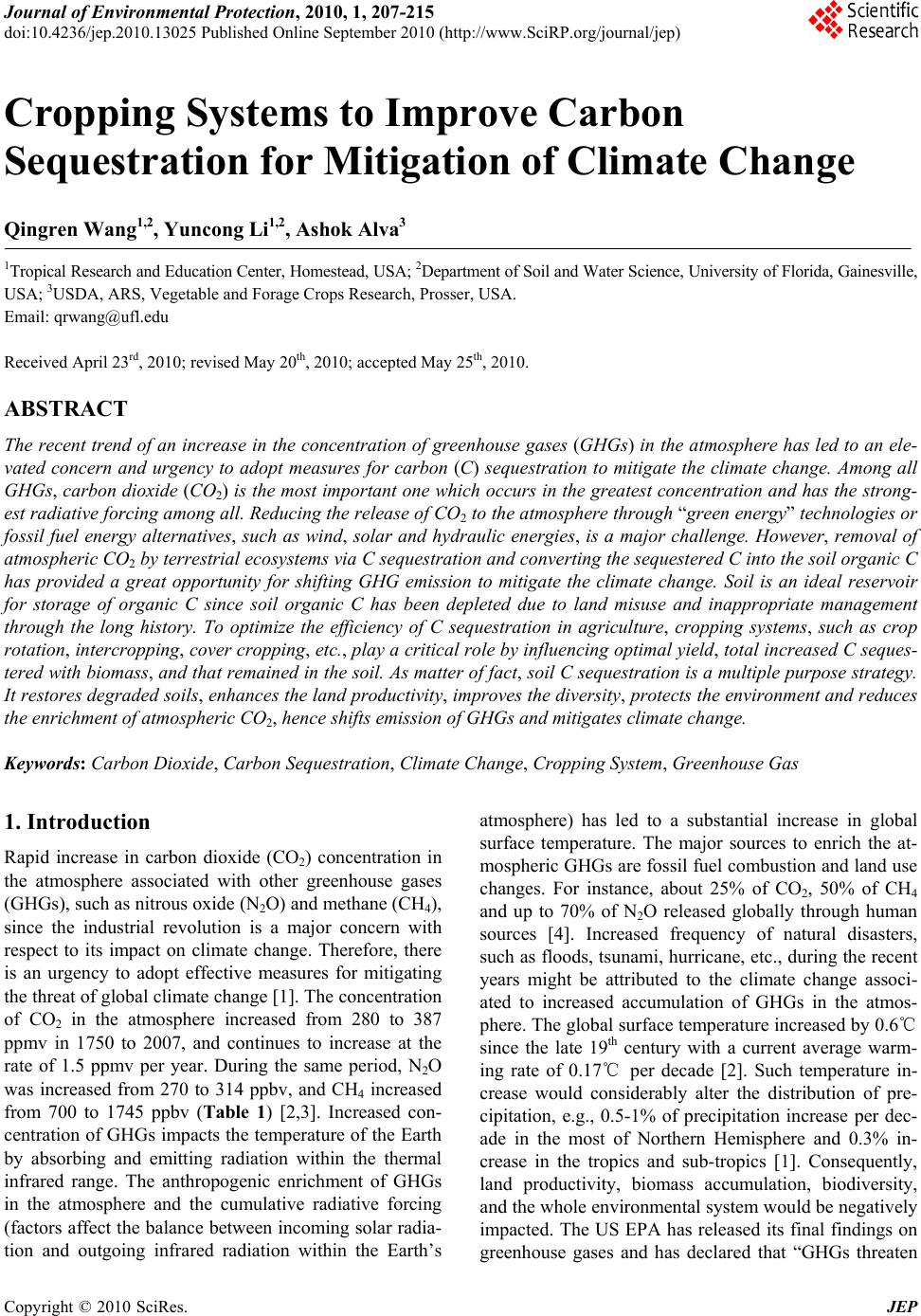 Journal of Environmental Protection, 2010, 1, 207-215 doi:10.4236/jep.2010.13025 Published Online September 2010 (http://www.SciRP.org/journal/jep) Copyright © 2010 SciRes. JEP 207 Cropping Systems to Improve Carbon Sequestration for Mitigation of Climate Change Qingren Wang1,2, Yuncong Li1,2, Ashok Alva3 1Tropical Research and Education Center, Homestead, USA; 2Department of Soil and Water Science, University of Florida, Gainesville, USA; 3USDA, ARS, Vegetable and Forage Crops Research, Prosser, USA. Email: qrwang@ufl.edu Received April 23rd, 2010; revised May 20th, 2010; accepted May 25th, 2010. ABSTRACT The recent trend of an increase in the concentration of greenhouse gases (GHGs) in the atmosphere has led to an ele- vated concern and urgency to adopt measures for carbon (C) sequestration to mitigate the climate change. Among all GHGs, carbon dioxide (CO2) is the most important one which occurs in the greatest concentration and has the strong- est radiative forcing among all. Reducing the release of CO2 to the atmosphere through “green energy” technologies or fossil fuel energy alternatives, such as wind, solar and hydraulic energies, is a major challenge. However, removal of atmospheric CO2 by terrestrial ecosystems via C sequestration and converting the sequestered C into the soil organic C has provided a great opportunity for shifting GHG emission to mitigate the climate change. Soil is an ideal reservoir for storage of organic C since soil organic C has been depleted due to land misuse and inappropriate management through the long history. To optimize the efficiency of C sequestration in agriculture, cropping systems, such as crop rotation, intercropping, cover cropping, etc., play a critical role by influencing optimal yield, total increased C seques- tered with biomass, and that remained in the soil. As matter of fact, soil C sequestration is a multiple purpose strategy. It restores degraded soils, enhances the land productivity, improves the diversity, protects the environment and reduces the enrichment of atmospheric CO2, hence shifts emission of GHGs and mitigates climate change. Keywords: Carbon Dioxide, Carbon Sequestration, Climate Change, Cropping System, Greenhouse Gas 1. Introduction Rapid increase in carbon dioxide (CO2) concentration in the atmosphere associated with other greenhouse gases (GHGs), such as nitrous oxide (N2O) and methane (CH4), since the industrial revolution is a major concern with respect to its impact on climate change. Therefore, there is an urgency to adopt effective measures for mitigating the threat of global climate change [1]. The concentration of CO2 in the atmosphere increased from 280 to 387 ppmv in 1750 to 2007, and continues to increase at the rate of 1.5 ppmv per year. During the same period, N2O was increased from 270 to 314 ppbv, and CH4 increased from 700 to 1745 ppbv (Table 1) [2,3]. Increased con- centration of GHGs impacts the temperature of the Earth by absorbing and emitting radiation within the thermal infrared range. The anthropogenic enrichment of GHGs in the atmosphere and the cumulative radiative forcing (factors affect the balance between incoming solar radia- tion and outgoing infrared radiation within the Earth’s atmosphere) has led to a substantial increase in global surface temperature. The major sources to enrich the at- mospheric GHGs are fossil fuel combustion and land use changes. For instance, about 25% of CO2, 50% of CH4 and up to 70% of N2O released globally through human sources [4]. Increased frequency of natural disasters, such as floods, tsunami, hurricane, etc., during the recent years might be attributed to the climate change associ- ated to increased accumulation of GHGs in the atmos- phere. The global surface temperature increased by 0.6℃ since the late 19th century with a current average warm- ing rate of 0.17℃ per decade [2]. Such temperature in- crease would considerably alter the distribution of pre- cipitation, e.g., 0.5-1% of precipitation increase per dec- ade in the most of Northern Hemisphere and 0.3% in- crease in the tropics and sub-tropics [1]. Consequently, land productivity, biomass accumulation, biodiversity, and the whole environmental system would be negatively impacted. The US EPA has released its final findings on greenhouse gases and has declared that “GHGs threaten  Cropping Systems to Improve Carbon Sequestration for Mitigation of Climate Change Copyright © 2010 SciRes. JEP 208 the public health and welfare of the American people” [5]. Therefore, it is urgent to adopt practical and effective approaches to controlling the GHG emission for mitigat- ing global climate change for a sustainable development of the environment. The objective of this review is to briefly elucidate the main sources of GHG emission and particularly address the sustainable development of crop- ping systems for carbon sequestration to mitigate the threat of the global climate change. 2. Major Sources of GHGs and their Contributions A major source of CO2 in the atmosphere is fossil fuel combustion and cement production. Total emission from the above source increased from 5.4 ± 0.3 to 7.9 Pg C yr-1 in the global scale in 1980s; 6.3 ± 0.4 Pg C yr-1 from the same source in the 1990s; and up to 7.9 Pg C yr-1 from 1980 to 2005 [1,6]. Over 70% of the total emission is from combustion of liquid and solid fuels. Land use change, such as deforestation, land degradation, etc. also contribute to anthropogenic CO2 emission [1,7,8], which has been constant at about 1.7 ± 0.8 Pg C yr-1 during 1980s through 2005. The global emission of carbon is estimated at 270 ± 30 Pg due to fossil fuel combustion and 136 ± 55 Pg due to land use change and soil cultiva- tion during the last 150 years [1,9-11]. The CO2 emission rate has increased dramatically since 2000, as evident from an increase from 1.1% during 1990-1999, to > 3% since 2000. This is attributed to increased energy demand with an increase in gross domestic product (GDP) [6]. Besides CO2, there are some other gases that can con- tribute the global climate change. However, the contribu- tion to the greenhouse effect by different gases is deter- mined by the characteristics of the gas and its abundance. For instance, CH4 is about 8 fold stronger than CO2 on a molecule-for-molecule basis, however the net contribu- tion of CH4 to the greenhouse effect is much smaller be- cause its lower concentration than that of CO2. From the radiative forcing of the main GHGs, CO2, CH4 and N2O (Table 1), it is also evident that CO2 is the predominant GHG. Similarly, the other three GHGs named in the Kyoto Protocol, hydrofluorocarbons, perfluorocarbons, and sulfur hexafluoride (US EPA, 2009) may impact the climate change but their radiative forcing is considerably low due to their very low concentrations as compared to that of CO2. Therefore, it is important to control the con- centration of atmospheric CO2 by reducing its emission by using fossil fuel more efficiently than ever before, and by adoption of “green-energy technologies”, such as fos- sil fuel alternatives, solar, wind, hydraulic energies, etc. On the other hand, terrestrial plants play a critical role to remove the atmospheric CO2 via their photosynthesis and assimilation of CO2 to produce plant biomass. 3. Carbon Sequestration for Shifting GHG Mitigation Carbon sequestration by terrestrial vegetation, as one of the most effective options for shifting the GHG emission has been identified by the Intergovernmental Panel on Climate Change [2]. Terrestrial ecosystems associated with land use and soil management play an important role in the global C budget [1]. For example, the current terrestrial sink for carbon is estimated to hold 550-700 Pg of carbon in the world’s vegetation and 1200-1600 Pg of soil organic carbon [8]. This has shown a great potential to offset the total amount of C emitted and accumulated in the atmosphere through all possible sources. Therefore, the United Nations (UN) Framework Con- vention on Climate Change (UNFCC) has setup 3 major conventions to combat desertification, land degradation, and improving biodiversity. Furthermore, the Kyoto Protocol, negotiated in 1997, provides the framework for activities aimed at reducing emissions of GHGs. The protocol contains a joint commitment of the industrial- ized countries to reduce their GHG emissions by at least 5% below the levels of 1990, over the period of 2008- 2012 [12]. The removal of atmospheric CO2 by increasing the as- similation of CO2 with terrestrial vegetation, retaining C and enhancing the transformation of atmospheric C to plant biomass and soil organic matter along with reduc- ing GHG emission has become a worldwide strategy to Table 1. Increase of dominant greenhouse gases and their radiative forcing [3]. Greenhouse gases Preindustrial level Current level Increase Radiative forcing (W/m2) CO2 280 ppmv 387 ppmv 107 ppmv 38% 1.46 CH4 700 ppbv 1745 ppbv 1045 ppbv 149% 0.48 N2O 270 ppbv 314 ppbv 44 ppbv 16% 0.15 CFC-12* 0 533 pptv 533 pptv - 0.17 *CFC: chlorofluorocarbon 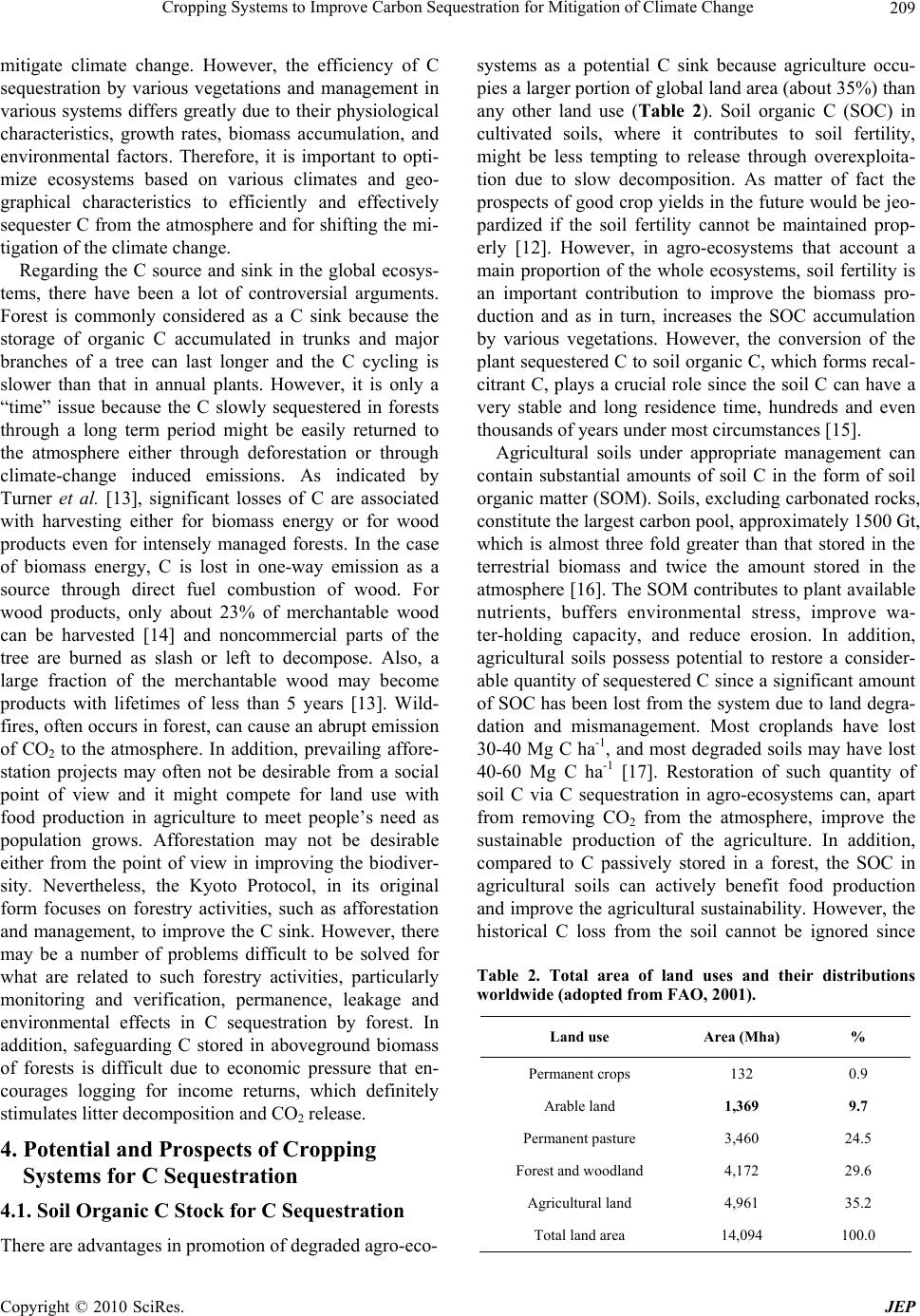 Cropping Systems to Improve Carbon Sequestration for Mitigation of Climate Change Copyright © 2010 SciRes. JEP 209 mitigate climate change. However, the efficiency of C sequestration by various vegetations and management in various systems differs greatly due to their physiological characteristics, growth rates, biomass accumulation, and environmental factors. Therefore, it is important to opti- mize ecosystems based on various climates and geo- graphical characteristics to efficiently and effectively sequester C from the atmosphere and for shifting the mi- tigation of the climate change. Regarding the C source and sink in the global ecosys- tems, there have been a lot of controversial arguments. Forest is commonly considered as a C sink because the storage of organic C accumulated in trunks and major branches of a tree can last longer and the C cycling is slower than that in annual plants. However, it is only a “time” issue because the C slowly sequestered in forests through a long term period might be easily returned to the atmosphere either through deforestation or through climate-change induced emissions. As indicated by Turner et al. [13], significant losses of C are associated with harvesting either for biomass energy or for wood products even for intensely managed forests. In the case of biomass energy, C is lost in one-way emission as a source through direct fuel combustion of wood. For wood products, only about 23% of merchantable wood can be harvested [14] and noncommercial parts of the tree are burned as slash or left to decompose. Also, a large fraction of the merchantable wood may become products with lifetimes of less than 5 years [13]. Wild- fires, often occurs in forest, can cause an abrupt emission of CO2 to the atmosphere. In addition, prevailing affore- station projects may often not be desirable from a social point of view and it might compete for land use with food production in agriculture to meet people’s need as population grows. Afforestation may not be desirable either from the point of view in improving the biodiver- sity. Nevertheless, the Kyoto Protocol, in its original form focuses on forestry activities, such as afforestation and management, to improve the C sink. However, there may be a number of problems difficult to be solved for what are related to such forestry activities, particularly monitoring and verification, permanence, leakage and environmental effects in C sequestration by forest. In addition, safeguarding C stored in aboveground biomass of forests is difficult due to economic pressure that en- courages logging for income returns, which definitely stimulates litter decomposition and CO2 release. 4. Potential and Prospects of Cropping Systems for C Sequestration 4.1. Soil Organic C Stock for C Sequestration There are advantages in promotion of degraded agro-eco- systems as a potential C sink because agriculture occu- pies a larger portion of global land area (about 35%) than any other land use (Table 2). Soil organic C (SOC) in cultivated soils, where it contributes to soil fertility, might be less tempting to release through overexploita- tion due to slow decomposition. As matter of fact the prospects of good crop yields in the future would be jeo- pardized if the soil fertility cannot be maintained prop- erly [12]. However, in agro-ecosystems that account a main proportion of the whole ecosystems, soil fertility is an important contribution to improve the biomass pro- duction and as in turn, increases the SOC accumulation by various vegetations. However, the conversion of the plant sequestered C to soil organic C, which forms recal- citrant C, plays a crucial role since the soil C can have a very stable and long residence time, hundreds and even thousands of years under most circumstances [15]. Agricultural soils under appropriate management can contain substantial amounts of soil C in the form of soil organic matter (SOM). Soils, excluding carbonated rocks, constitute the largest carbon pool, approximately 1500 Gt, which is almost three fold greater than that stored in the terrestrial biomass and twice the amount stored in the atmosphere [16]. The SOM contributes to plant available nutrients, buffers environmental stress, improve wa- ter-holding capacity, and reduce erosion. In addition, agricultural soils possess potential to restore a consider- able quantity of sequestered C since a significant amount of SOC has been lost from the system due to land degra- dation and mismanagement. Most croplands have lost 30-40 Mg C ha-1, and most degraded soils may have lost 40-60 Mg C ha-1 [17]. Restoration of such quantity of soil C via C sequestration in agro-ecosystems can, apart from removing CO2 from the atmosphere, improve the sustainable production of the agriculture. In addition, compared to C passively stored in a forest, the SOC in agricultural soils can actively benefit food production and improve the agricultural sustainability. However, the historical C loss from the soil cannot be ignored since Table 2. Total area of land uses and their distributions worldwide (adopted from FAO, 2001). Land use Area (Mha) % Permanent crops 132 0.9 Arable land 1,369 9.7 Permanent pasture 3,460 24.5 Forest and woodland 4,172 29.6 Agricultural land 4,961 35.2 Total land area 14,094 100.0 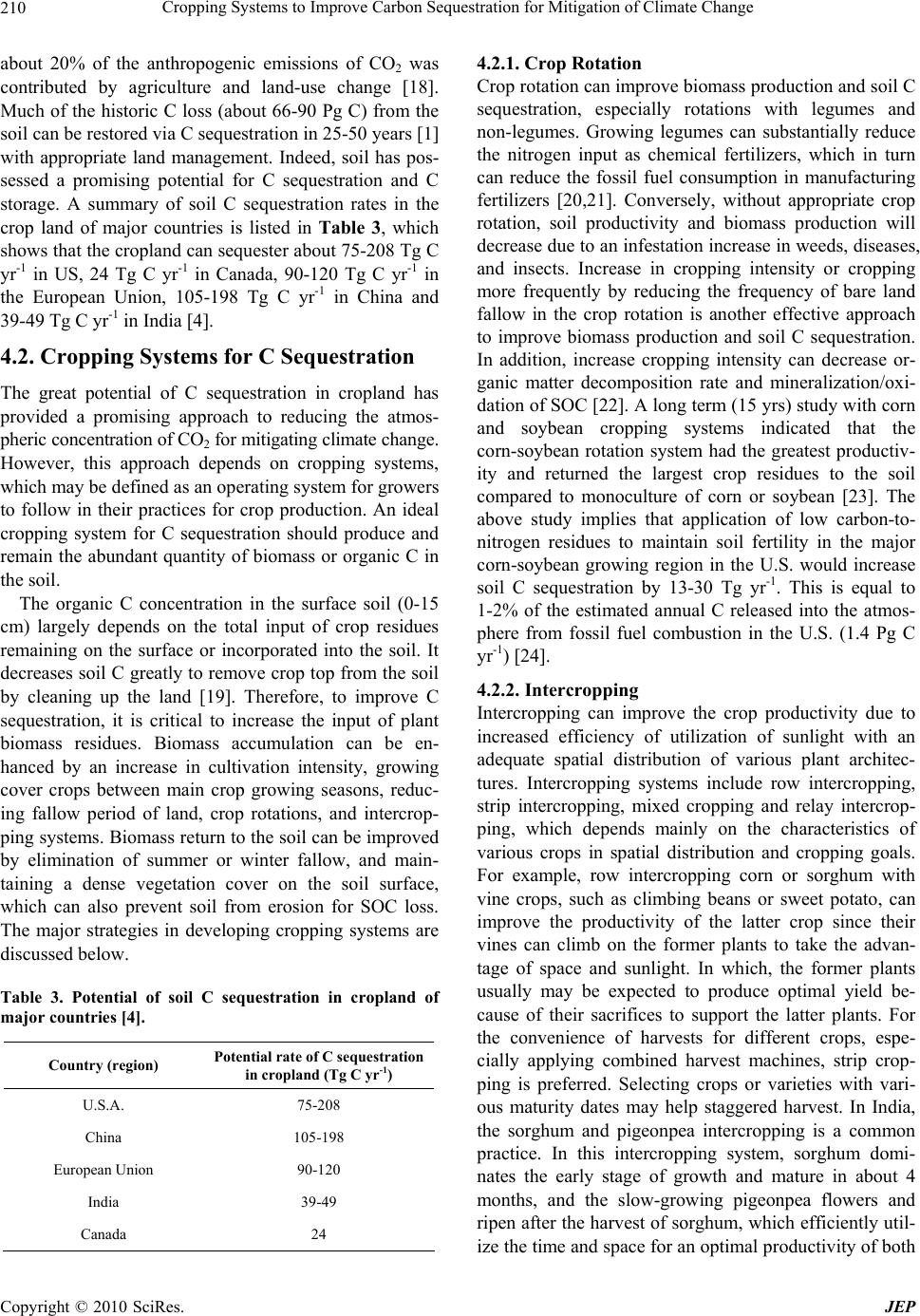 Cropping Systems to Improve Carbon Sequestration for Mitigation of Climate Change Copyright © 2010 SciRes. JEP 210 about 20% of the anthropogenic emissions of CO2 was contributed by agriculture and land-use change [18]. Much of the historic C loss (about 66-90 Pg C) from the soil can be restored via C sequestration in 25-50 years [1] with appropriate land management. Indeed, soil has pos- sessed a promising potential for C sequestration and C storage. A summary of soil C sequestration rates in the crop land of major countries is listed in Table 3, which shows that the cropland can sequester about 75-208 Tg C yr-1 in US, 24 Tg C yr-1 in Canada, 90-120 Tg C yr-1 in the European Union, 105-198 Tg C yr-1 in China and 39-49 Tg C yr-1 in India [4]. 4.2. Cropping Systems for C Sequestration The great potential of C sequestration in cropland has provided a promising approach to reducing the atmos- pheric concentration of CO2 for mitigating climate change. However, this approach depends on cropping systems, which may be defined as an operating system for growers to follow in their practices for crop production. An ideal cropping system for C sequestration should produce and remain the abundant quantity of biomass or organic C in the soil. The organic C concentration in the surface soil (0-15 cm) largely depends on the total input of crop residues remaining on the surface or incorporated into the soil. It decreases soil C greatly to remove crop top from the soil by cleaning up the land [19]. Therefore, to improve C sequestration, it is critical to increase the input of plant biomass residues. Biomass accumulation can be en- hanced by an increase in cultivation intensity, growing cover crops between main crop growing seasons, reduc- ing fallow period of land, crop rotations, and intercrop- ping systems. Biomass return to the soil can be improved by elimination of summer or winter fallow, and main- taining a dense vegetation cover on the soil surface, which can also prevent soil from erosion for SOC loss. The major strategies in developing cropping systems are discussed below. Table 3. Potential of soil C sequestration in cropland of major countries [4]. Country (region) Potential rate of C sequestration in cropland (Tg C yr-1) U.S.A. 75-208 China 105-198 European Union 90-120 India 39-49 Canada 24 4.2.1. Crop Rotation Crop rotation can improve biomass production and soil C sequestration, especially rotations with legumes and non-legumes. Growing legumes can substantially reduce the nitrogen input as chemical fertilizers, which in turn can reduce the fossil fuel consumption in manufacturing fertilizers [20,21]. Conversely, without appropriate crop rotation, soil productivity and biomass production will decrease due to an infestation increase in weeds, diseases, and insects. Increase in cropping intensity or cropping more frequently by reducing the frequency of bare land fallow in the crop rotation is another effective approach to improve biomass production and soil C sequestration. In addition, increase cropping intensity can decrease or- ganic matter decomposition rate and mineralization/oxi- dation of SOC [22]. A long term (15 yrs) study with corn and soybean cropping systems indicated that the corn-soybean rotation system had the greatest productiv- ity and returned the largest crop residues to the soil compared to monoculture of corn or soybean [23]. The above study implies that application of low carbon-to- nitrogen residues to maintain soil fertility in the major corn-soybean growing region in the U.S. would increase soil C sequestration by 13-30 Tg yr-1. This is equal to 1-2% of the estimated annual C released into the atmos- phere from fossil fuel combustion in the U.S. (1.4 Pg C yr-1) [24]. 4.2.2. Intercropping Intercropping can improve the crop productivity due to increased efficiency of utilization of sunlight with an adequate spatial distribution of various plant architec- tures. Intercropping systems include row intercropping, strip intercropping, mixed cropping and relay intercrop- ping, which depends mainly on the characteristics of various crops in spatial distribution and cropping goals. For example, row intercropping corn or sorghum with vine crops, such as climbing beans or sweet potato, can improve the productivity of the latter crop since their vines can climb on the former plants to take the advan- tage of space and sunlight. In which, the former plants usually may be expected to produce optimal yield be- cause of their sacrifices to support the latter plants. For the convenience of harvests for different crops, espe- cially applying combined harvest machines, strip crop- ping is preferred. Selecting crops or varieties with vari- ous maturity dates may help staggered harvest. In India, the sorghum and pigeonpea intercropping is a common practice. In this intercropping system, sorghum domi- nates the early stage of growth and mature in about 4 months, and the slow-growing pigeonpea flowers and ripen after the harvest of sorghum, which efficiently util- ize the time and space for an optimal productivity of both 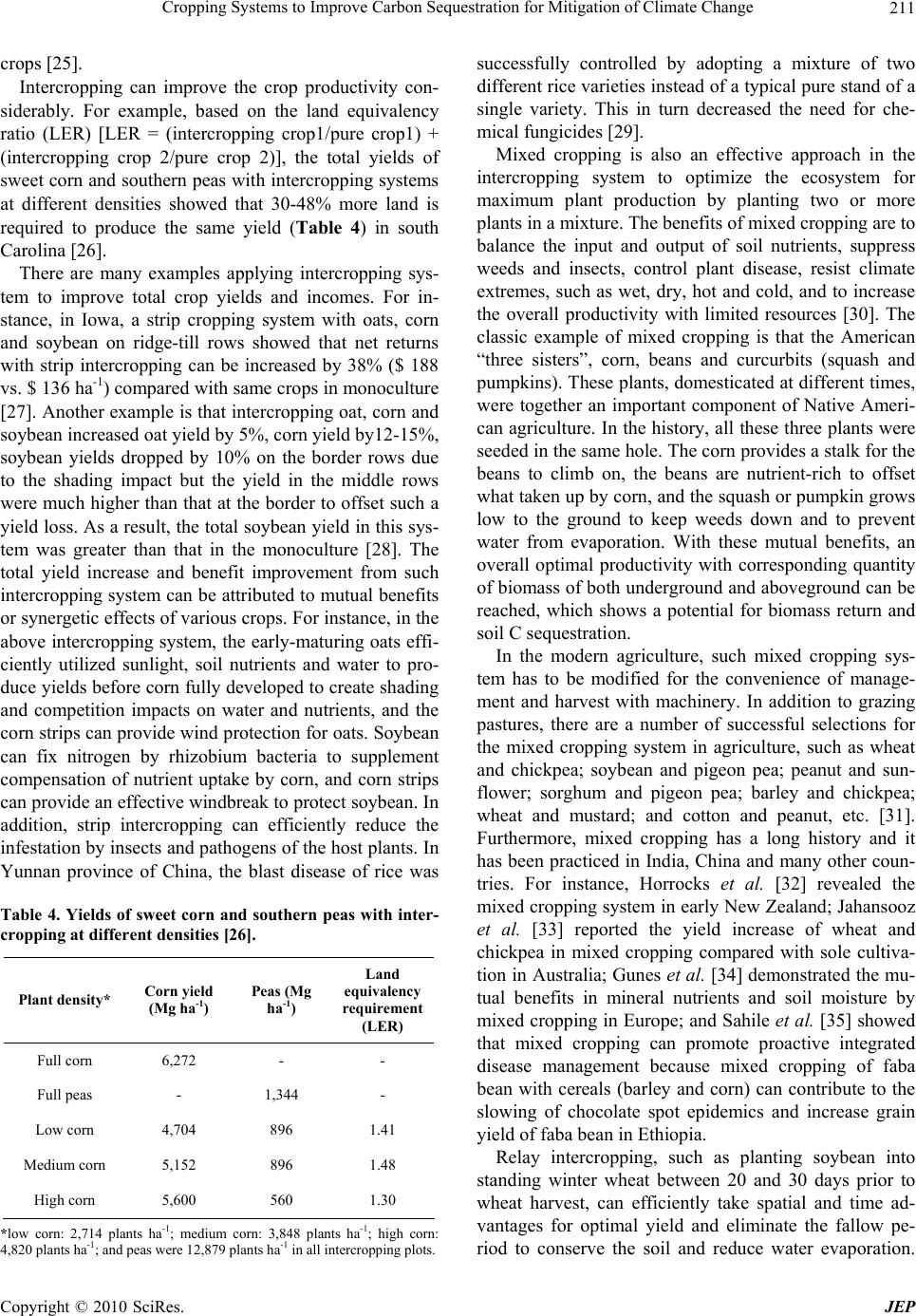 Cropping Systems to Improve Carbon Sequestration for Mitigation of Climate Change Copyright © 2010 SciRes. JEP 211 crops [25]. Intercropping can improve the crop productivity con- siderably. For example, based on the land equivalency ratio (LER) [LER = (intercropping crop1/pure crop1) + (intercropping crop 2/pure crop 2)], the total yields of sweet corn and southern peas with intercropping systems at different densities showed that 30-48% more land is required to produce the same yield (Table 4) in south Carolina [26]. There are many examples applying intercropping sys- tem to improve total crop yields and incomes. For in- stance, in Iowa, a strip cropping system with oats, corn and soybean on ridge-till rows showed that net returns with strip intercropping can be increased by 38% ($ 188 vs. $ 136 ha-1) compared with same crops in monoculture [27]. Another example is that intercropping oat, corn and soybean increased oat yield by 5%, corn yield by12-15%, soybean yields dropped by 10% on the border rows due to the shading impact but the yield in the middle rows were much higher than that at the border to offset such a yield loss. As a result, the total soybean yield in this sys- tem was greater than that in the monoculture [28]. The total yield increase and benefit improvement from such intercropping system can be attributed to mutual benefits or synergetic effects of various crops. For instance, in the above intercropping system, the early-maturing oats effi- ciently utilized sunlight, soil nutrients and water to pro- duce yields before corn fully developed to create shading and competition impacts on water and nutrients, and the corn strips can provide wind protection for oats. Soybean can fix nitrogen by rhizobium bacteria to supplement compensation of nutrient uptake by corn, and corn strips can provide an effective windbreak to protect soybean. In addition, strip intercropping can efficiently reduce the infestation by insects and pathogens of the host plants. In Yunnan province of China, the blast disease of rice was Table 4. Yields of sweet corn and southern peas with inter- cropping at different densities [26]. Plant density* Corn yield (Mg ha-1) Peas (Mg ha-1) Land equivalency requirement (LER) Full corn 6,272 - - Full peas - 1,344 - Low corn 4,704 896 1.41 Medium corn 5,152 896 1.48 High corn 5,600 560 1.30 *low corn: 2,714 plants ha-1; medium corn: 3,848 plants ha-1; high corn: 4,820 plants ha-1; and peas were 12,879 plants ha-1 in all intercropping plots. successfully controlled by adopting a mixture of two different rice varieties instead of a typical pure stand of a single variety. This in turn decreased the need for che- mical fungicides [29]. Mixed cropping is also an effective approach in the intercropping system to optimize the ecosystem for maximum plant production by planting two or more plants in a mixture. The benefits of mixed cropping are to balance the input and output of soil nutrients, suppress weeds and insects, control plant disease, resist climate extremes, such as wet, dry, hot and cold, and to increase the overall productivity with limited resources [30]. The classic example of mixed cropping is that the American “three sisters”, corn, beans and curcurbits (squash and pumpkins). These plants, domesticated at different times, were together an important component of Native Ameri- can agriculture. In the history, all these three plants were seeded in the same hole. The corn provides a stalk for the beans to climb on, the beans are nutrient-rich to offset what taken up by corn, and the squash or pumpkin grows low to the ground to keep weeds down and to prevent water from evaporation. With these mutual benefits, an overall optimal productivity with corresponding quantity of biomass of both underground and aboveground can be reached, which shows a potential for biomass return and soil C sequestration. In the modern agriculture, such mixed cropping sys- tem has to be modified for the convenience of manage- ment and harvest with machinery. In addition to grazing pastures, there are a number of successful selections for the mixed cropping system in agriculture, such as wheat and chickpea; soybean and pigeon pea; peanut and sun- flower; sorghum and pigeon pea; barley and chickpea; wheat and mustard; and cotton and peanut, etc. [31]. Furthermore, mixed cropping has a long history and it has been practiced in India, China and many other coun- tries. For instance, Horrocks et al. [32] revealed the mixed cropping system in early New Zealand; Jahansooz et al. [33] reported the yield increase of wheat and chickpea in mixed cropping compared with sole cultiva- tion in Australia; Gunes et al. [34] demonstrated the mu- tual benefits in mineral nutrients and soil moisture by mixed cropping in Europe; and Sahile et al. [35] showed that mixed cropping can promote proactive integrated disease management because mixed cropping of faba bean with cereals (barley and corn) can contribute to the slowing of chocolate spot epidemics and increase grain yield of faba bean in Ethiopia. Relay intercropping, such as planting soybean into standing winter wheat between 20 and 30 days prior to wheat harvest, can efficiently take spatial and time ad- vantages for optimal yield and eliminate the fallow pe- riod to conserve the soil and reduce water evaporation. 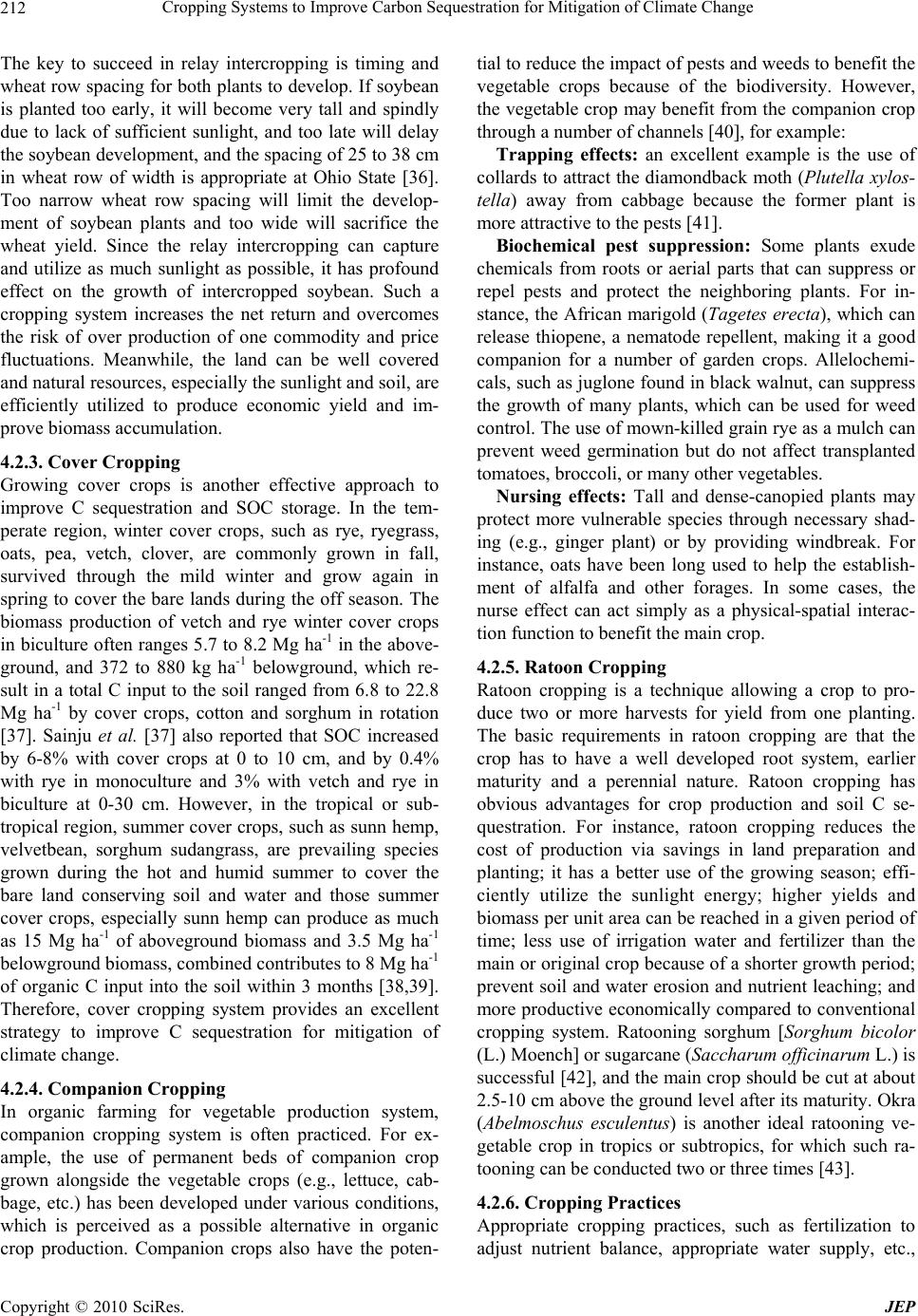 Cropping Systems to Improve Carbon Sequestration for Mitigation of Climate Change Copyright © 2010 SciRes. JEP 212 The key to succeed in relay intercropping is timing and wheat row spacing for both plants to develop. If soybean is planted too early, it will become very tall and spindly due to lack of sufficient sunlight, and too late will delay the soybean development, and the spacing of 25 to 38 cm in wheat row of width is appropriate at Ohio State [36]. Too narrow wheat row spacing will limit the develop- ment of soybean plants and too wide will sacrifice the wheat yield. Since the relay intercropping can capture and utilize as much sunlight as possible, it has profound effect on the growth of intercropped soybean. Such a cropping system increases the net return and overcomes the risk of over production of one commodity and price fluctuations. Meanwhile, the land can be well covered and natural resources, especially the sunlight and soil, are efficiently utilized to produce economic yield and im- prove biomass accumulation. 4.2.3. Cover Cropping Growing cover crops is another effective approach to improve C sequestration and SOC storage. In the tem- perate region, winter cover crops, such as rye, ryegrass, oats, pea, vetch, clover, are commonly grown in fall, survived through the mild winter and grow again in spring to cover the bare lands during the off season. The biomass production of vetch and rye winter cover crops in biculture often ranges 5.7 to 8.2 Mg ha-1 in the above- ground, and 372 to 880 kg ha-1 belowground, which re- sult in a total C input to the soil ranged from 6.8 to 22.8 Mg ha-1 by cover crops, cotton and sorghum in rotation [37]. Sainju et al. [37] also reported that SOC increased by 6-8% with cover crops at 0 to 10 cm, and by 0.4% with rye in monoculture and 3% with vetch and rye in biculture at 0-30 cm. However, in the tropical or sub- tropical region, summer cover crops, such as sunn hemp, velvetbean, sorghum sudangrass, are prevailing species grown during the hot and humid summer to cover the bare land conserving soil and water and those summer cover crops, especially sunn hemp can produce as much as 15 Mg ha-1 of aboveground biomass and 3.5 Mg ha-1 belowground biomass, combined contributes to 8 Mg ha-1 of organic C input into the soil within 3 months [38,39]. Therefore, cover cropping system provides an excellent strategy to improve C sequestration for mitigation of climate change. 4.2.4. Companion Cropping In organic farming for vegetable production system, companion cropping system is often practiced. For ex- ample, the use of permanent beds of companion crop grown alongside the vegetable crops (e.g., lettuce, cab- bage, etc.) has been developed under various conditions, which is perceived as a possible alternative in organic crop production. Companion crops also have the poten- tial to reduce the impact of pests and weeds to benefit the vegetable crops because of the biodiversity. However, the vegetable crop may benefit from the companion crop through a number of channels [40], for example: Trapping effects: an excellent example is the use of collards to attract the diamondback moth (Plutella xylos- tella) away from cabbage because the former plant is more attractive to the pests [41]. Biochemical pest suppression: Some plants exude chemicals from roots or aerial parts that can suppress or repel pests and protect the neighboring plants. For in- stance, the African marigold (Tagetes erecta), which can release thiopene, a nematode repellent, making it a good companion for a number of garden crops. Allelochemi- cals, such as juglone found in black walnut, can suppress the growth of many plants, which can be used for weed control. The use of mown-killed grain rye as a mulch can prevent weed germination but do not affect transplanted tomatoes, broccoli, or many other vegetables. Nursing effects: Tall and dense-canopied plants may protect more vulnerable species through necessary shad- ing (e.g., ginger plant) or by providing windbreak. For instance, oats have been long used to help the establish- ment of alfalfa and other forages. In some cases, the nurse effect can act simply as a physical-spatial interac- tion function to benefit the main crop. 4.2.5. Ratoon Cropping Ratoon cropping is a technique allowing a crop to pro- duce two or more harvests for yield from one planting. The basic requirements in ratoon cropping are that the crop has to have a well developed root system, earlier maturity and a perennial nature. Ratoon cropping has obvious advantages for crop production and soil C se- questration. For instance, ratoon cropping reduces the cost of production via savings in land preparation and planting; it has a better use of the growing season; effi- ciently utilize the sunlight energy; higher yields and biomass per unit area can be reached in a given period of time; less use of irrigation water and fertilizer than the main or original crop because of a shorter growth period; prevent soil and water erosion and nutrient leaching; and more productive economically compared to conventional cropping system. Ratooning sorghum [Sorghum bicolor (L.) Moench] or sugarcane (Saccharum officinarum L.) is successful [42], and the main crop should be cut at about 2.5-10 cm above the ground level after its maturity. Okra (Abelmoschus esculentus) is another ideal ratooning ve- getable crop in tropics or subtropics, for which such ra- tooning can be conducted two or three times [43]. 4.2.6. Cropping Practices Appropriate cropping practices, such as fertilization to adjust nutrient balance, appropriate water supply, etc., 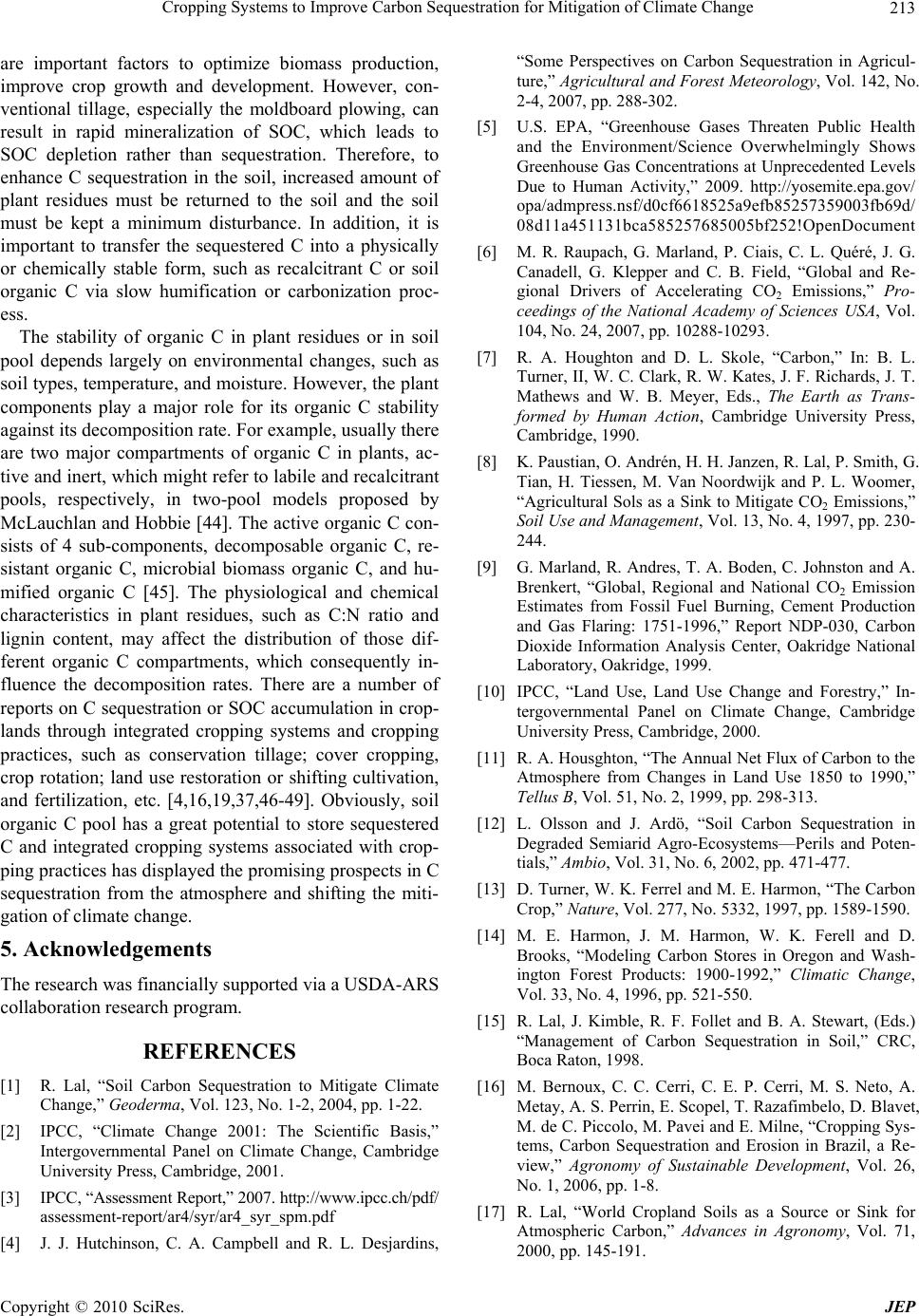 Cropping Systems to Improve Carbon Sequestration for Mitigation of Climate Change Copyright © 2010 SciRes. JEP 213 are important factors to optimize biomass production, improve crop growth and development. However, con- ventional tillage, especially the moldboard plowing, can result in rapid mineralization of SOC, which leads to SOC depletion rather than sequestration. Therefore, to enhance C sequestration in the soil, increased amount of plant residues must be returned to the soil and the soil must be kept a minimum disturbance. In addition, it is important to transfer the sequestered C into a physically or chemically stable form, such as recalcitrant C or soil organic C via slow humification or carbonization proc- ess. The stability of organic C in plant residues or in soil pool depends largely on environmental changes, such as soil types, temperature, and moisture. However, the plant components play a major role for its organic C stability against its decomposition rate. For example, usually there are two major compartments of organic C in plants, ac- tive and inert, which might refer to labile and recalcitrant pools, respectively, in two-pool models proposed by McLauchlan and Hobbie [44]. The active organic C con- sists of 4 sub-components, decomposable organic C, re- sistant organic C, microbial biomass organic C, and hu- mified organic C [45]. The physiological and chemical characteristics in plant residues, such as C:N ratio and lignin content, may affect the distribution of those dif- ferent organic C compartments, which consequently in- fluence the decomposition rates. There are a number of reports on C sequestration or SOC accumulation in crop- lands through integrated cropping systems and cropping practices, such as conservation tillage; cover cropping, crop rotation; land use restoration or shifting cultivation, and fertilization, etc. [4,16,19,37,46-49]. Obviously, soil organic C pool has a great potential to store sequestered C and integrated cropping systems associated with crop- ping practices has displayed the promising prospects in C sequestration from the atmosphere and shifting the miti- gation of climate change. 5. Acknowledgements The research was financially supported via a USDA-ARS collaboration research program. REFERENCES [1] R. Lal, “Soil Carbon Sequestration to Mitigate Climate Change,” Geoderma, Vol. 123, No. 1-2, 2004, pp. 1-22. [2] IPCC, “Climate Change 2001: The Scientific Basis,” Intergovernmental Panel on Climate Change, Cambridge University Press, Cambridge, 2001. [3] IPCC, “Assessment Report,” 2007. http://www.ipcc.ch/pdf/ assessment-report/ar4/syr/ar4_syr_spm.pdf [4] J. J. Hutchinson, C. A. Campbell and R. L. Desjardins, “Some Perspectives on Carbon Sequestration in Agricul- ture,” Agricultural and Forest Meteorology, Vol. 142, No. 2-4, 2007, pp. 288-302. [5] U.S. EPA, “Greenhouse Gases Threaten Public Health and the Environment/Science Overwhelmingly Shows Greenhouse Gas Concentrations at Unprecedented Levels Due to Human Activity,” 2009. http://yosemite.epa.gov/ opa/admpress.nsf/d0cf6618525a9efb85257359003fb69d/ 08d11a451131bca585257685005bf252!OpenDocument [6] M. R. Raupach, G. Marland, P. Ciais, C. L. Quéré, J. G. Canadell, G. Klepper and C. B. Field, “Global and Re- gional Drivers of Accelerating CO2 Emissions,” Pro- ceedings of the National Academy of Sciences USA, Vol. 104, No. 24, 2007, pp. 10288-10293. [7] R. A. Houghton and D. L. Skole, “Carbon,” In: B. L. Turner, II, W. C. Clark, R. W. Kates, J. F. Richards, J. T. Mathews and W. B. Meyer, Eds., The Earth as Trans- formed by Human Action, Cambridge University Press, Cambridge, 1990. [8] K. Paustian, O. Andrén, H. H. Janzen, R. Lal, P. Smith, G. Tian, H. Tiessen, M. Van Noordwijk and P. L. Woomer, “Agricultural Sols as a Sink to Mitigate CO2 Emissions,” Soil Use and Management, Vol. 13, No. 4, 1997, pp. 230- 244. [9] G. Marland, R. Andres, T. A. Boden, C. Johnston and A. Brenkert, “Global, Regional and National CO2 Emission Estimates from Fossil Fuel Burning, Cement Production and Gas Flaring: 1751-1996,” Report NDP-030, Carbon Dioxide Information Analysis Center, Oakridge National Laboratory, Oakridge, 1999. [10] IPCC, “Land Use, Land Use Change and Forestry,” In- tergovernmental Panel on Climate Change, Cambridge University Press, Cambridge, 2000. [11] R. A. Housghton, “The Annual Net Flux of Carbon to the Atmosphere from Changes in Land Use 1850 to 1990,” Tellus B, Vol. 51, No. 2, 1999, pp. 298-313. [12] L. Olsson and J. Ardö, “Soil Carbon Sequestration in Degraded Semiarid Agro-Ecosystems—Perils and Poten- tials,” Ambio, Vol. 31, No. 6, 2002, pp. 471-477. [13] D. Turner, W. K. Ferrel and M. E. Harmon, “The Carbon Crop,” Nature, Vol. 277, No. 5332, 1997, pp. 1589-1590. [14] M. E. Harmon, J. M. Harmon, W. K. Ferell and D. Brooks, “Modeling Carbon Stores in Oregon and Wash- ington Forest Products: 1900-1992,” Climatic Change, Vol. 33, No. 4, 1996, pp. 521-550. [15] R. Lal, J. Kimble, R. F. Follet and B. A. Stewart, (Eds.) “Management of Carbon Sequestration in Soil,” CRC, Boca Raton, 1998. [16] M. Bernoux, C. C. Cerri, C. E. P. Cerri, M. S. Neto, A. Metay, A. S. Perrin, E. Scopel, T. Razafimbelo, D. Blavet, M. de C. Piccolo, M. Pavei and E. Milne, “Cropping Sys- tems, Carbon Sequestration and Erosion in Brazil, a Re- view,” Agronomy of Sustainable Development, Vol. 26, No. 1, 2006, pp. 1-8. [17] R. Lal, “World Cropland Soils as a Source or Sink for Atmospheric Carbon,” Advances in Agronomy, Vol. 71, 2000, pp. 145-191. 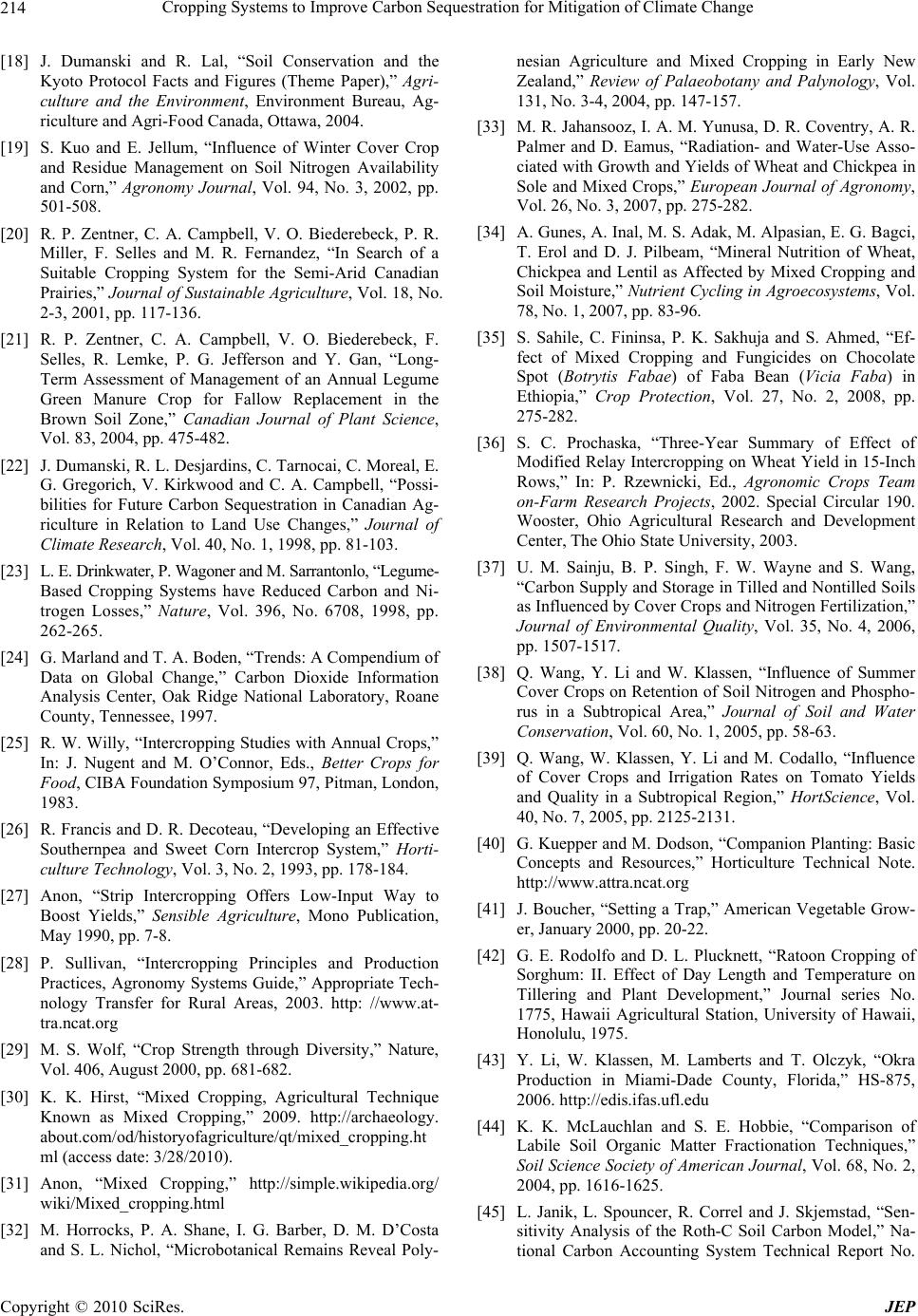 Cropping Systems to Improve Carbon Sequestration for Mitigation of Climate Change Copyright © 2010 SciRes. JEP 214 [18] J. Dumanski and R. Lal, “Soil Conservation and the Kyoto Protocol Facts and Figures (Theme Paper),” Agri- culture and the Environment, Environment Bureau, Ag- riculture and Agri-Food Canada, Ottawa, 2004. [19] S. Kuo and E. Jellum, “Influence of Winter Cover Crop and Residue Management on Soil Nitrogen Availability and Corn,” Agronomy Journal, Vol. 94, No. 3, 2002, pp. 501-508. [20] R. P. Zentner, C. A. Campbell, V. O. Biederebeck, P. R. Miller, F. Selles and M. R. Fernandez, “In Search of a Suitable Cropping System for the Semi-Arid Canadian Prairies,” Journal of Sustainable Agriculture, Vol. 18, No. 2-3, 2001, pp. 117-136. [21] R. P. Zentner, C. A. Campbell, V. O. Biederebeck, F. Selles, R. Lemke, P. G. Jefferson and Y. Gan, “Long- Term Assessment of Management of an Annual Legume Green Manure Crop for Fallow Replacement in the Brown Soil Zone,” Canadian Journal of Plant Science, Vol. 83, 2004, pp. 475-482. [22] J. Dumanski, R. L. Desjardins, C. Tarnocai, C. Moreal, E. G. Gregorich, V. Kirkwood and C. A. Campbell, “Possi- bilities for Future Carbon Sequestration in Canadian Ag- riculture in Relation to Land Use Changes,” Journal of Climate Research, Vol. 40, No. 1, 1998, pp. 81-103. [23] L. E. Drinkwater, P. Wagoner and M. Sarrantonlo, “Legume- Based Cropping Systems have Reduced Carbon and Ni- trogen Losses,” Nature, Vol. 396, No. 6708, 1998, pp. 262-265. [24] G. Marland and T. A. Boden, “Trends: A Compendium of Data on Global Change,” Carbon Dioxide Information Analysis Center, Oak Ridge National Laboratory, Roane County, Tennessee, 1997. [25] R. W. Willy, “Intercropping Studies with Annual Crops,” In: J. Nugent and M. O’Connor, Eds., Better Crops for Food, CIBA Foundation Symposium 97, Pitman, London, 1983. [26] R. Francis and D. R. Decoteau, “Developing an Effective Southernpea and Sweet Corn Intercrop System,” Horti- culture Technology, Vol. 3, No. 2, 1993, pp. 178-184. [27] Anon, “Strip Intercropping Offers Low-Input Way to Boost Yields,” Sensible Agriculture, Mono Publication, May 1990, pp. 7-8. [28] P. Sullivan, “Intercropping Principles and Production Practices, Agronomy Systems Guide,” Appropriate Tech- nology Transfer for Rural Areas, 2003. http: //www.at- tra.ncat.org [29] M. S. Wolf, “Crop Strength through Diversity,” Nature, Vol. 406, August 2000, pp. 681-682. [30] K. K. Hirst, “Mixed Cropping, Agricultural Technique Known as Mixed Cropping,” 2009. http://archaeology. about.com/od/historyofagriculture/qt/mixed_cropping.ht ml (access date: 3/28/2010). [31] Anon, “Mixed Cropping,” http://simple.wikipedia.org/ wiki/Mixed_cropping.html [32] M. Horrocks, P. A. Shane, I. G. Barber, D. M. D’Costa and S. L. Nichol, “Microbotanical Remains Reveal Poly- nesian Agriculture and Mixed Cropping in Early New Zealand,” Review of Palaeobotany and Palynology, Vol. 131, No. 3-4, 2004, pp. 147-157. [33] M. R. Jahansooz, I. A. M. Yunusa, D. R. Coventry, A. R. Palmer and D. Eamus, “Radiation- and Water-Use Asso- ciated with Growth and Yields of Wheat and Chickpea in Sole and Mixed Crops,” European Journal of Agronomy, Vol. 26, No. 3, 2007, pp. 275-282. [34] A. Gunes, A. Inal, M. S. Adak, M. Alpasian, E. G. Bagci, T. Erol and D. J. Pilbeam, “Mineral Nutrition of Wheat, Chickpea and Lentil as Affected by Mixed Cropping and Soil Moisture,” Nutrient Cycling in Agroecosystems, Vol. 78, No. 1, 2007, pp. 83-96. [35] S. Sahile, C. Fininsa, P. K. Sakhuja and S. Ahmed, “Ef- fect of Mixed Cropping and Fungicides on Chocolate Spot (Botrytis Fabae) of Faba Bean (Vicia Faba) in Ethiopia,” Crop Protection, Vol. 27, No. 2, 2008, pp. 275-282. [36] S. C. Prochaska, “Three-Year Summary of Effect of Modified Relay Intercropping on Wheat Yield in 15-Inch Rows,” In: P. Rzewnicki, Ed., Agronomic Crops Team on-Farm Research Projects, 2002. Special Circular 190. Wooster, Ohio Agricultural Research and Development Center, The Ohio State University, 2003. [37] U. M. Sainju, B. P. Singh, F. W. Wayne and S. Wang, “Carbon Supply and Storage in Tilled and Nontilled Soils as Influenced by Cover Crops and Nitrogen Fertilization,” Journal of Environmental Quality, Vol. 35, No. 4, 2006, pp. 1507-1517. [38] Q. Wang, Y. Li and W. Klassen, “Influence of Summer Cover Crops on Retention of Soil Nitrogen and Phospho- rus in a Subtropical Area,” Journal of Soil and Water Conservation, Vol. 60, No. 1, 2005, pp. 58-63. [39] Q. Wang, W. Klassen, Y. Li and M. Codallo, “Influence of Cover Crops and Irrigation Rates on Tomato Yields and Quality in a Subtropical Region,” HortScience, Vol. 40, No. 7, 2005, pp. 2125-2131. [40] G. Kuepper and M. Dodson, “Companion Planting: Basic Concepts and Resources,” Horticulture Technical Note. http://www.attra.ncat.org [41] J. Boucher, “Setting a Trap,” American Vegetable Grow- er, January 2000, pp. 20-22. [42] G. E. Rodolfo and D. L. Plucknett, “Ratoon Cropping of Sorghum: II. Effect of Day Length and Temperature on Tillering and Plant Development,” Journal series No. 1775, Hawaii Agricultural Station, University of Hawaii, Honolulu, 1975. [43] Y. Li, W. Klassen, M. Lamberts and T. Olczyk, “Okra Production in Miami-Dade County, Florida,” HS-875, 2006. http://edis.ifas.ufl.edu [44] K. K. McLauchlan and S. E. Hobbie, “Comparison of Labile Soil Organic Matter Fractionation Techniques,” Soil Science Society of American Journal, Vol. 68, No. 2, 2004, pp. 1616-1625. [45] L. Janik, L. Spouncer, R. Correl and J. Skjemstad, “Sen- sitivity Analysis of the Roth-C Soil Carbon Model,” Na- tional Carbon Accounting System Technical Report No. 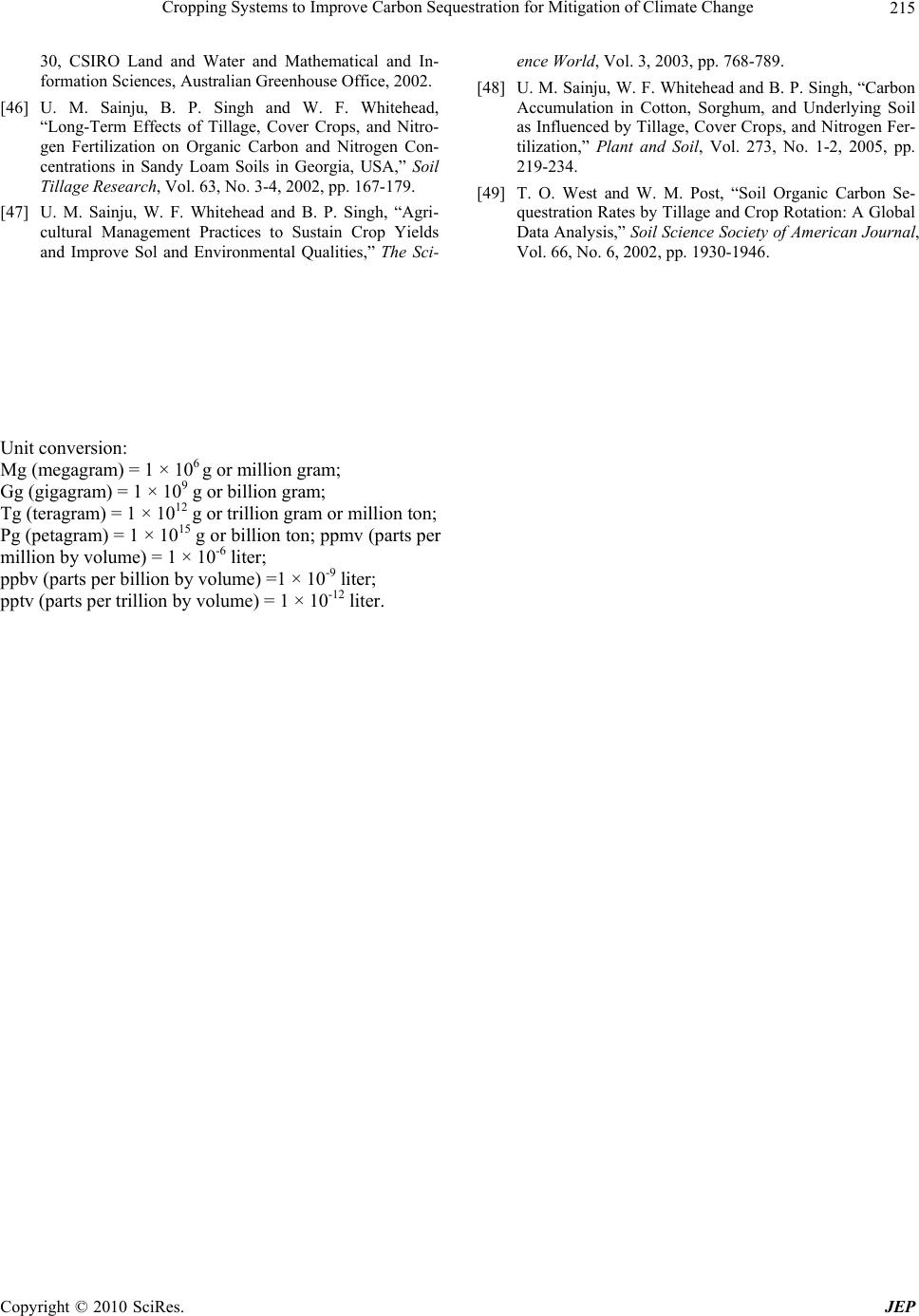 Cropping Systems to Improve Carbon Sequestration for Mitigation of Climate Change Copyright © 2010 SciRes. JEP 215 30, CSIRO Land and Water and Mathematical and In- formation Sciences, Australian Greenhouse Office, 2002. [46] U. M. Sainju, B. P. Singh and W. F. Whitehead, “Long-Term Effects of Tillage, Cover Crops, and Nitro- gen Fertilization on Organic Carbon and Nitrogen Con- centrations in Sandy Loam Soils in Georgia, USA,” Soil Tillage Research, Vol. 63, No. 3-4, 2002, pp. 167-179. [47] U. M. Sainju, W. F. Whitehead and B. P. Singh, “Agri- cultural Management Practices to Sustain Crop Yields and Improve Sol and Environmental Qualities,” The Sci- ence World, Vol. 3, 2003, pp. 768-789. [48] U. M. Sainju, W. F. Whitehead and B. P. Singh, “Carbon Accumulation in Cotton, Sorghum, and Underlying Soil as Influenced by Tillage, Cover Crops, and Nitrogen Fer- tilization,” Plant and Soil, Vol. 273, No. 1-2, 2005, pp. 219-234. [49] T. O. West and W. M. Post, “Soil Organic Carbon Se- questration Rates by Tillage and Crop Rotation: A Global Data Analysis,” Soil Science Society of American Journal, Vol. 66, No. 6, 2002, pp. 1930-1946. Unit conversion: Mg (megagram) = 1 × 106 g or million gram; Gg (gigagram) = 1 × 109 g or billion gram; Tg (teragram) = 1 × 1012 g or trillion gram or million ton; Pg (petagram) = 1 × 1015 g or billion ton; ppmv (parts per million by volume) = 1 × 10-6 liter; ppbv (parts per billion by volume) =1 × 10-9 liter; pptv (parts per trillion by volume) = 1 × 10-12 liter. |

